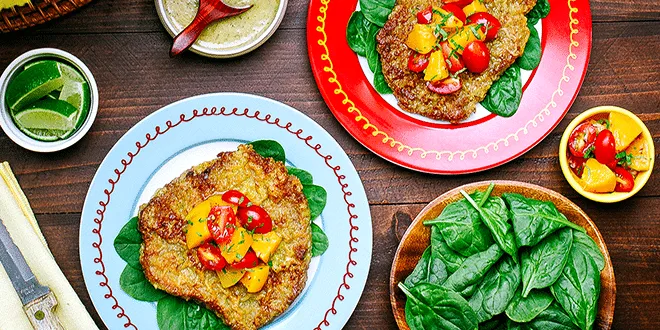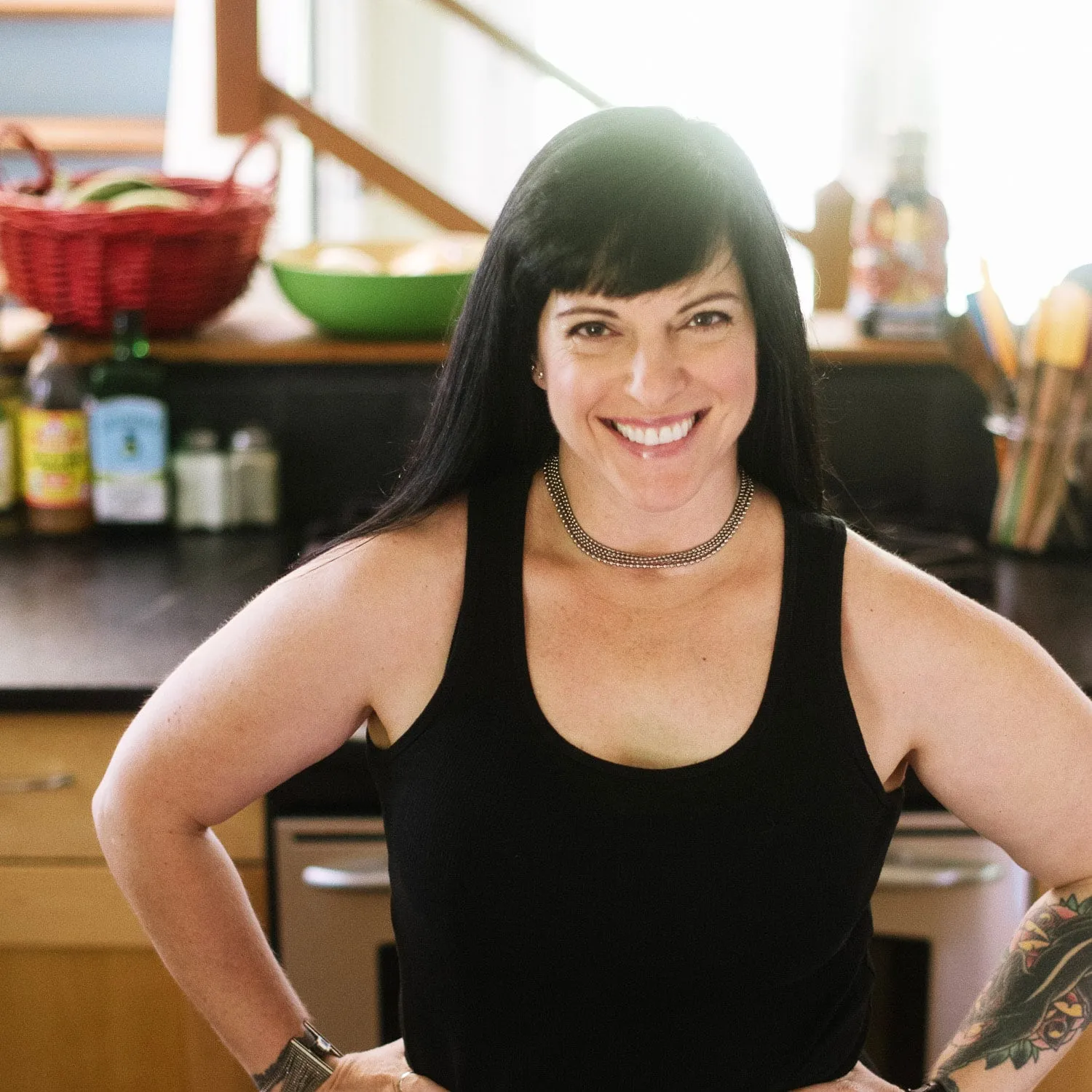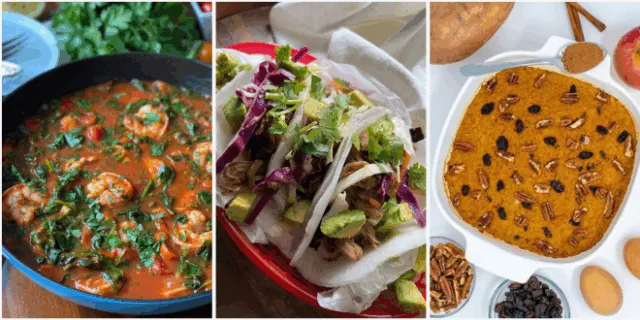From Whole30 co-founder Melissa Urban: To say I Mel Joulwan is one of my favorite humans ever is an understatement. Mel has been one of My People since before the Whole30 was even in existence, and in a way, she grew and shaped the program right there with us, offering her feedback, sharing her results and struggles, and giving her expert advice to her Well Fed community and ours. She, like, GETS IT, and her cookbooks (including the new Well Fed Weeknights, which I am so excited to cook from) reflect this exact philosophy. I hope you love this concept as much as I do.
Eating, yay! Cooking, not so much.
I have a confession to make that might seem strange coming from a cookbook author: Cooking is not my favorite thing… Eating is my favorite thing. Maybe you feel that way, too. But if you’re a Whole30-er, eating delicious, healthy things means you probably need to cook more often than you might like. And while eating well is a big part of an awesome life, it’s not the only thing. There’s yoga class, chauffeuring your kids, making time for romance, and appeasing a demanding boss. There’s laundry and grocery shopping and meal planning and taxes and so many other mandatory to-dos. In the midst of all of that, the addition of cooking a fresh, wholesome, from-scratch meal can be overwhelming—never mind that if you’re on the Food Freedom path (I like to think of it as the path of the righteous), that meal needs to be nutritious and flavorful, and something your potentially picky dining partners will actually eat (preferably without complaint).  You might be one of the fortunate: a leisurely cook who enjoys spending time in the kitchen. (Happy cooks, I salute you!) I am not. When I’m in Make Dinner mode, I’m a dervish. I go full speed with all the burners fired up and multiple timers ticking. My focus is on the sizzle of fat in the skillet, the aroma of the spice clouds hovering above the stove. Now that I see it in type, it seems romantic, but it’s not. I’m no Nigella Lawson! My weeknight kitchen vibe is all about getting it done as quickly as possible. That go-go approach, however, is in direct conflict with one of the most important concepts of the Whole30 program. The Whole30 and, ultimately, Food Freedom are built on the idea of making conscious decisions about what we eat, savoring our food, and eating mindfully so our souls are nourished while we feed our bodies. Today I want to share the mantra that’s taken hold in our house:
You might be one of the fortunate: a leisurely cook who enjoys spending time in the kitchen. (Happy cooks, I salute you!) I am not. When I’m in Make Dinner mode, I’m a dervish. I go full speed with all the burners fired up and multiple timers ticking. My focus is on the sizzle of fat in the skillet, the aroma of the spice clouds hovering above the stove. Now that I see it in type, it seems romantic, but it’s not. I’m no Nigella Lawson! My weeknight kitchen vibe is all about getting it done as quickly as possible. That go-go approach, however, is in direct conflict with one of the most important concepts of the Whole30 program. The Whole30 and, ultimately, Food Freedom are built on the idea of making conscious decisions about what we eat, savoring our food, and eating mindfully so our souls are nourished while we feed our bodies. Today I want to share the mantra that’s taken hold in our house:
Cook quickly, eat slowly.
I’ve been working on the “cook quickly” part for the past two years, developing recipes that are the kinds of things I like to eat: Luscious things. Gloppy things. Spicy things. Crispy things. All the delicious things! That kitchen research lead to my new cookbook Well Fed Weeknights: Complete Paleo Meals in 45 Minutes Or Less. All of the recipes make a complete meal—protein, veggies, and fats—sometimes in one pan (!) and 100 of the recipes are ready in half-an-hour or less.  The recipes are inspired by food trucks, secret restaurant menus, and crazy-good meals I’ve eaten on my travels. I live by the Whole30 guidelines, so the recipes are free of grains, dairy, legumes, and soy, and there are options for a little added sweetener once in a while if you’ve found your food freedom. These new recipes minimize the time and stress that can sometimes go along with getting a healthy, luscious meal on the table. And bonus! They’re really fun to make and eat. But as anyone who’s tackled the Whole30 knows, food is only part of the equation. As much as I love food, I haven’t always been a good eater. For nearly 30 years, I don’t think I ever truly enjoyed my food. I was either on a deprivation diet, eating “punishment food” like salad with low-fat dressing, plain grilled chicken, and steamed broccoli with lemon juice. Or I was enjoying the “eat whatever you want, deal with the consequences later” diet plan that came with a free side dish of self-recrimination and a dessert course of shame. Thanks to Melissa’s friendship and the Whole30, I’ve learned to take pleasure in food like never before, while still making good choices about what makes it onto my plate. (I know Melissa calls that Food Freedom; I call it peace.) Even if you’re new to the Whole30, you can start using mindfulness right now to enjoy your food more and begin to improve your digestive health. In Food Freedom Forever, Melissa explains her love of Cadbury Créme Eggs. For emotional reasons, they’re a favorite from her childhood, and every year before Easter, she receives a 3-pack from her mom. “This year,” she writes, “on a random Thursday at 2:30 in the afternoon, I decided I wanted one. I unwrapped it, sat down on the couch, sighed contentedly, and savored every tiny bite. I made that egg last a solid 20 minutes, then I texted my mom to say thank you.” I believe that’s the best way to approach everyday meals, too! Deliberately, with joy, and with an appreciation for the aroma, taste, and texture of every bite. Warning: The following tips may sound like the kind of thing you heard from your mom at the dining table when you were eight years old. As much as it pains me to say it, sometimes moms really are right. (Thanks, Mom!)
The recipes are inspired by food trucks, secret restaurant menus, and crazy-good meals I’ve eaten on my travels. I live by the Whole30 guidelines, so the recipes are free of grains, dairy, legumes, and soy, and there are options for a little added sweetener once in a while if you’ve found your food freedom. These new recipes minimize the time and stress that can sometimes go along with getting a healthy, luscious meal on the table. And bonus! They’re really fun to make and eat. But as anyone who’s tackled the Whole30 knows, food is only part of the equation. As much as I love food, I haven’t always been a good eater. For nearly 30 years, I don’t think I ever truly enjoyed my food. I was either on a deprivation diet, eating “punishment food” like salad with low-fat dressing, plain grilled chicken, and steamed broccoli with lemon juice. Or I was enjoying the “eat whatever you want, deal with the consequences later” diet plan that came with a free side dish of self-recrimination and a dessert course of shame. Thanks to Melissa’s friendship and the Whole30, I’ve learned to take pleasure in food like never before, while still making good choices about what makes it onto my plate. (I know Melissa calls that Food Freedom; I call it peace.) Even if you’re new to the Whole30, you can start using mindfulness right now to enjoy your food more and begin to improve your digestive health. In Food Freedom Forever, Melissa explains her love of Cadbury Créme Eggs. For emotional reasons, they’re a favorite from her childhood, and every year before Easter, she receives a 3-pack from her mom. “This year,” she writes, “on a random Thursday at 2:30 in the afternoon, I decided I wanted one. I unwrapped it, sat down on the couch, sighed contentedly, and savored every tiny bite. I made that egg last a solid 20 minutes, then I texted my mom to say thank you.” I believe that’s the best way to approach everyday meals, too! Deliberately, with joy, and with an appreciation for the aroma, taste, and texture of every bite. Warning: The following tips may sound like the kind of thing you heard from your mom at the dining table when you were eight years old. As much as it pains me to say it, sometimes moms really are right. (Thanks, Mom!)
Pause and reflect
It can be very tough to downshift from the doing task of making dinner to the eating phase of the meal, so a deliberate pause between plating your food and taking your first bite is a helpful to change course. I like to arrange my utensils and dish just so, let my gaze slowly rove over my food, and take a deep inhale-exhale to let the frenetic cooking energy dissipate. Some people say a prayer or express gratitude for their meal, to themselves or aloud. Experiment to find the ritual that’s right for you, that short routine that will help you pause and reflect before you eat. That kind of mental break contributes to a physical state that will aid digestion and produce feelings of satisfaction.
Eat at the table
We have an awesome table in our kitchen, but I don’t always sit at the dining table to eat. I have a lot of energy in the morning, and sometimes at breakfast I feel too antsy to park my butt, so I stand at the counter with my plate. On workout days, I often take my post-workout snack (sweet potatoes, roasted chicken, water) on the wooded trail behind the gym and eat it while I stroll down the path. In both of these cases, I still do step number one; I take a pause, sniff my food, and engage my senses before I dig in. But the vast majority of my meals are eaten at the big wooden table in our kitchen. It’s the hub of our house, and it’s our designated spot to mealtimes. You don’t need a formal dining table or a big space to make this habit work. It’s the act of slowing down to eat—in a space devoted to eating—that puts you in the mindset to focus on your food. It sends a message to your brain that says, “I’m eating now,” so your senses and digestion can begin the act of nourishing you.
Say no to screens
Fact: We eat more when we’re distracted. That’s why it’s vital to shut down the television, computer, phone, tablet, and other gadgets while you eat. The entertainment and diversion of screens is a distraction from the food you eat, and that can you leave you feeling unsatisfied at the end of the meal. When you eat in front of a screen, your brain doesn’t register the satiety that should be attached to the food because your attention is being stolen by that cute cat video or stressful work email. Ban gadgets from your table and focus on the food.
Use a plate, bowl, and utensils
I’ve already admitted that I often eat standing up and while walking in the woods, so I might as well confess that when I eat alone, I sometimes eat straight from the cooking pan. I mean, no one can see me and why should I wash extra dishes?! (I also really love meals that I can eat with my fingers. #sorrynotsorry) If you have similar urges, I recommend that you don’t give in to them on the regular (although, it can be relaxing and indulgent once in a while). You’ll feel more satisfied—and be more successful in achieving your health-related goals—if you place appropriate servings of protein and vegetables on a smallish, individual serving plate. Normal-sized portions served on smaller plates trick your brain into thinking you’re eating more, leading you to feel more satisfied when you’re finished.
Fork down, chew well
My parents were sticklers for good table manners when I was kid. We always ate dinner together at our kitchen table, and I was instructed repeatedly to put my fork down between bites. There was no shoveling allowed; human-sized bites only, please. And no one left the table until everyone was finished eating. That meant there was no reason to eat quickly because my mom was, and continues to be, the most leisurely eater on the planet. Those annoying rules were actually excellent advice, so I’m passing them along to you with affection: Place your fork on the rim of your plate between bites to ensure you don’t snarf your food too quickly. (Or as Melissa says in Food Freedom Forever, “… stop eating like you’re in prison.”) And here’s another tip for you: Chew each bite of food a lot, somewhere between 30 and 50 times. Research shows that digestion and satiation improve when food is well chewed before being swallowed.
Wait 20 minutes
This is an old-school dieter’s trick that is actually legit. (As my husband like to say, “Even a blind pig finds a truffle once in a while.”) It takes about 20 minutes for the “I’m full” message to reach the brain. To give your head time to catch up with what your mouth and stomach have been chowing down, eat slowly and pause until at least the 20-minute mark before hitting the stove for seconds. If you still feel unsatisfied after the waiting period, add another small serving of protein and vegetables to your plate and savor every bite.
Enjoy your food
For about thirty years, I tortured myself with diets. They all had different rules, but shared one essential point: If you’re dieting, food isn’t meant to be pleasurable and white-knuckle discipline is required. (Subtext: And then you’ll not only be skinny, you’ll also be a Good Person.) One of the great gifts of the Whole30 and learning to live with Food Freedom is that there is no shame in finding pleasure in the food you eat every day. In fact, there are times when it’s OK for you to eat that fresh ear of corn in the summer or that perfect, pink, strawberry macaron in Paris simply for the pleasure of it. The key is making those choices consciously and with plenty of self-compassion. I hope this has inspired you to explore new ways you can cook quickly and eat slowly. For 18 recipes that will help you cook quickly, treat yourself to this free 70-page sampler of Well Fed Weeknights. And that “eat slowly” business? You can try that the very next time you eat!
 Melissa Joulwan is the author of the best-selling Well Fed cookbook series and the blog www.MelJoulwan.com, where she writes about her triumphs and failures in the gym, in the kitchen, and in life. Her newest cookbook is Well Fed Weeknights: Complete Paleo Meals in 45 Minutes Or Less (available for pre-sale now, with a release date of November 1, 2016). After a lifetime of yo-yo dieting and food as the enemy, Melissa found the Whole30 in 2009 and has been happily following it ever since. That year, she also underwent a thyroidectomy. In the aftermath of the surgery and recovery, she became very interested in how what she eats affects her hormones, body composition, mood, and motivation. These days, Melissa’s workouts are just as likely to include yoga and meditation as lifting heavy things and sprinting to stay ahead of the stopwatch. Her favorite book is Jane Eyre and her favorite spice is cumin. She would perish without sparkly things, liquid eyeliner, and stompy black boots. Next April, she’s moving to Prague with her husband Dave and their cat Smudge. Well Fed Weeknights is an affiliate partner, meaning we make a small commission on items sold via the links in this post. We love our select affiliates, and we hope you will too.
Melissa Joulwan is the author of the best-selling Well Fed cookbook series and the blog www.MelJoulwan.com, where she writes about her triumphs and failures in the gym, in the kitchen, and in life. Her newest cookbook is Well Fed Weeknights: Complete Paleo Meals in 45 Minutes Or Less (available for pre-sale now, with a release date of November 1, 2016). After a lifetime of yo-yo dieting and food as the enemy, Melissa found the Whole30 in 2009 and has been happily following it ever since. That year, she also underwent a thyroidectomy. In the aftermath of the surgery and recovery, she became very interested in how what she eats affects her hormones, body composition, mood, and motivation. These days, Melissa’s workouts are just as likely to include yoga and meditation as lifting heavy things and sprinting to stay ahead of the stopwatch. Her favorite book is Jane Eyre and her favorite spice is cumin. She would perish without sparkly things, liquid eyeliner, and stompy black boots. Next April, she’s moving to Prague with her husband Dave and their cat Smudge. Well Fed Weeknights is an affiliate partner, meaning we make a small commission on items sold via the links in this post. We love our select affiliates, and we hope you will too.

















